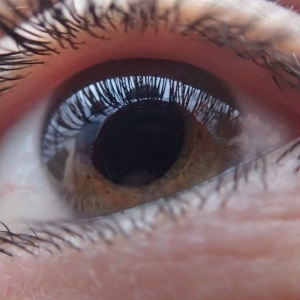 What is it?
What is it?
The Canadian Association of Optometrists defines Amblyopia as “weak vision or vision loss in one eye as a result of an uncorrected prescription during the early stages of development”. It is also commonly referred to as a “lazy eye”. It is caused when the brain doesn’t receive the right signals from the amblyopic eye – this could be due to a differing prescription than the other eye or due to misalignment of the eyes. Because images are being produced more clearly in the non-amblyopic eye, the brain starts to favour the eye, causing the Amblyopic eye to lose vision over time. Generally developing in childhood, kids with amblyopia have better vision in one eye that the other. This can be hard to spot as children often learn to live with their vision problems and don’t always understand that it is an issue.
Symptoms and Diagnosis
It can be difficult to diagnose Amblyopia, but if after regular eye drops, glasses or contact lenses haven’t helped correct a vision problem, it may be the possible diagnosis. Kids Health warns that “Kids often get used to this vision problem, and might not mention it to parents. As a result, their Amblyopia might not be diagnosed for months or even years, while parents chalk up poor grades or clumsiness to a child not being academically or athletically gifted.” Since children may not mention their vision problems, it’s a good idea to watch out for squinting, crossed eyes, or poor depth perception.
If you are noticing these symptoms in your child, take them in to see an eye doctor. The American Academy of Opthamology states that to diagnose Amblyopia, an ophthalmologist will check to see if there is differing vision between the eyes. They may cover one eye to see how a child tracks an object or may cover an eye with a patch. In addition to these tests, they will do a complete eye health exam to make sure nothing else underlying could be causing the vision problem.
Treatment
Early detection and treatment of Amblyopia, like any other health concern, is ideal. Treatment involves methods that allow the weaker eye to gain better vision over time, such as glasses, eye patches, eye drops, or surgery. Kids Health gives a good overview of which treatment is acceptable in different scenarios:
Glasses help to send clear images to the brain to “turn on” the weaker eye
Eye patches cover the good eye to help strengthen the weak eye
Eye drops (Atropine) are sometimes used in lieu of a patch as they blur vision in the strong eye to strengthen the weak eye
Surgery can be used to loosen or tighten the muscles causing the eye to wander if glasses or patching does not work.
If you suspect that your child has Amblyopia, make an appointment to see an eye care professional. When treated, vision can significantly increase. Left untreated, Amblyopia can lead to future vision problems and loss.
Contact Innovations in Eyecare if you need to schedule an optometrist appointment for Amblyopia today.
